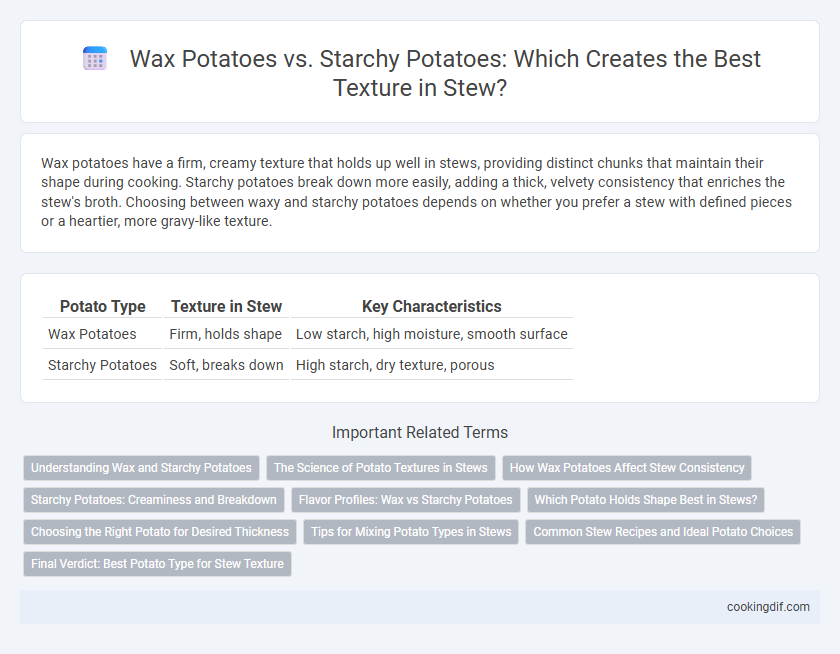Wax potatoes have a firm, creamy texture that holds up well in stews, providing distinct chunks that maintain their shape during cooking. Starchy potatoes break down more easily, adding a thick, velvety consistency that enriches the stew's broth. Choosing between waxy and starchy potatoes depends on whether you prefer a stew with defined pieces or a heartier, more gravy-like texture.
Table of Comparison
| Potato Type | Texture in Stew | Key Characteristics |
|---|---|---|
| Wax Potatoes | Firm, holds shape | Low starch, high moisture, smooth surface |
| Starchy Potatoes | Soft, breaks down | High starch, dry texture, porous |
Understanding Wax and Starchy Potatoes
Wax potatoes, such as red or fingerling varieties, have a lower starch content and a firmer, creamier texture that holds its shape well in stews. Starchy potatoes, like Russets, break down more during cooking, creating a thicker, creamier broth but less distinct potato chunks. Choosing wax potatoes enhances chunk integrity and bite, while starchy potatoes contribute to a richer, more velvety stew consistency.
The Science of Potato Textures in Stews
Wax potatoes retain their shape better in stews due to lower starch content and higher moisture, resulting in a firmer, creamier texture that resists turning mushy during prolonged cooking. Starchy potatoes, rich in amylose, break down more easily, thickening the stew's broth but creating a softer, fluffier consistency. Understanding the balance between waxy and starchy varieties allows for precise texture control, enhancing both the body and mouthfeel of stews.
How Wax Potatoes Affect Stew Consistency
Wax potatoes retain their shape and firmness during cooking, preventing stews from becoming overly thick or mushy. Their lower starch content results in a clearer, more broth-like consistency, which enhances the overall texture of the stew. Choosing wax potatoes ensures a stew with distinct, tender potato pieces that complement rather than dominate the dish's texture.
Starchy Potatoes: Creaminess and Breakdown
Starchy potatoes like Russets deliver a creamy texture and naturally break down during slow cooking, enriching stews with a velvety consistency. Their high starch content absorbs broth flavors while softening into a silky base that thickens the stew. This breakdown enhances the mouthfeel, creating a hearty and comforting dish.
Flavor Profiles: Wax vs Starchy Potatoes
Wax potatoes offer a firm texture with a subtle, buttery flavor that holds up well in stews, providing defined chunks that absorb seasonings without disintegrating. Starchy potatoes, such as Russets, break down more easily, creating a creamy, velvety consistency that enriches the stew's broth with a mild, earthy sweetness. Choosing between waxy and starchy potatoes impacts both the stew's texture and flavor intensity, influencing whether the dish features distinct potato pieces or a smooth, hearty thickness.
Which Potato Holds Shape Best in Stews?
Waxy potatoes such as Red Bliss or Fingerlings hold their shape best in stews due to their low starch content and firm, moist texture. Starchy potatoes like Russets tend to absorb liquid and break down, creating a creamier consistency but losing their form. Choosing waxy potatoes ensures distinct, tender chunks that maintain texture throughout slow cooking.
Choosing the Right Potato for Desired Thickness
Wax potatoes like Yukon Gold maintain their shape and create a creamier texture in stew, while starchy potatoes such as Russets break down more, thickening the broth naturally. Selecting waxy potatoes yields a chunkier consistency, ideal for stews requiring distinct potato pieces. Starchy varieties enhance stew thickness through their released starch, producing a thicker, more velvety sauce.
Tips for Mixing Potato Types in Stews
Combining waxy and starchy potatoes in stews balances texture, with waxy potatoes like Yukon Gold holding shape while starchy varieties such as Russets break down to thicken the broth. Trim waxy potatoes into larger chunks to retain firmness and cut starchy potatoes smaller for quicker disintegration. Stir gently to preserve the integrity of waxy potatoes while allowing starchy ones to meld into a creamy, velvety stew base.
Common Stew Recipes and Ideal Potato Choices
Wax potatoes like red or fingerling hold their shape and provide a firm, creamy texture ideal for common stew recipes requiring intact chunks, while starchy potatoes such as Russets break down easily, creating a thicker, almost porridge-like consistency. Most classic stew recipes, including beef or vegetable stews, favor waxy varieties to maintain texture contrast with tender meat and vegetables. Selecting the right potato type impacts the stew's overall mouthfeel and presentation, making waxy potatoes the preferred choice for balanced, hearty stews.
Final Verdict: Best Potato Type for Stew Texture
Waxy potatoes, such as red or fingerling varieties, hold their shape and provide a firm, creamy texture ideal for stews, preventing disintegration during long cooking times. Starchy potatoes, like Russets, tend to break down and create a thicker, more porridge-like consistency, which can overwhelm the stew's texture. For a perfect balance of softness and structure, waxy potatoes are the best choice to achieve a stew with distinct, tender chunks.
Wax vs Starchy Potatoes for Texture Infographic

 cookingdif.com
cookingdif.com